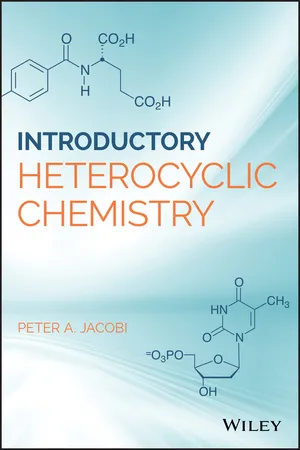
- English
- ePUB (mobile friendly)
- Available on iOS & Android
Introduction to Heterocyclic Chemistry
About This Book
A unique approach to a core topic in organic chemistry presented by an experienced teacher to students and professionals Heterocyclic rings are present in the majority of known natural products, contributing to enormous structural diversity. In addition, they often possess significant biological activity. Medicinal chemists have embraced this last property in designing most of the small molecule drugs in use today. This book offers readers a fundamental understanding of the basics of heterocyclic chemistry and their occurrence in natural products such as amino acids, DNA, vitamins, and antibiotics. Based on class lectures that the author has developed over more than 40 years of teaching, it focuses on the chemistry of such heterocyclic substances and how they differ from carbocyclic systems. Introductory Heterocyclic Chemistry offers in-depth chapters covering naturally occurring heterocycles; properties of aromatic heterocycles; ?-deficient heterocycles; ?-excessive heterocycles; and ring transformations of heterocycles. It then offers an overview of 1, 3-dipolar cycloadditions before finishing up with a back-to-basics section on nitriles and amidines.
- Presents a conversational approach to a fundamental topic in organic chemistry teaching
- Offers a unique look at this core organic chemistry topic via important naturally occurring and/or biologically active heterocycles
- Based on the author's many years of class lectures for teaching at the undergraduate and graduate level as well as pharmaceutical-industry courses
- Clear, concise, and accessible for advanced students of chemistry to gain a fundamental understanding of the basics of heterocyclic chemistry
Introductory Heterocyclic Chemistry is an excellent text for undergraduate and graduate students as well as chemists in industrial environments in chemistry, pharmacy, medicinal chemistry, and biology.
Frequently asked questions
Information
1
Some Biologically Important Heterocycles of Nature


1.1 Vitamins


Table of contents
- Cover
- Table of Contents
- Dedication
- Preface
- Acknowledgments
- Chapter 1: Some Biologically Important Heterocycles of Nature
- Chapter 2: Orbitals and Aromaticity; Chemical Reactivity
- Chapter 3: A Prelude to Synthesis
- Chapter 4: π‐Deficient Heterocycles: Some Physical Properties
- Chapter 5: π‐Deficient Heterocycles: De Novo Syntheses
- Chapter 6: π‐Deficient Heterocycles: Introduction of New Substituents: Nucleophilic Substitution
- Chapter 7: π‐Deficient Heterocycles: Introduction of New Substituents: Heterocyclic N‐Oxides
- Chapter 8: π‐Deficient Heterocycles: Introduction of New Substituents: Quinolines and Isoquinolines
- Chapter 9: π‐Deficient Heterocycles: Manipulation of Existing Substituents
- Chapter 10: π‐Excessive Heterocycles: General Properties
- Chapter 11: π‐Excessive Heterocycles: De Novo Syntheses
- Chapter 12: π‐Excessive Heterocycles: Introduction of New Substituents
- Chapter 13: Ring Transformations of π‐Excessive Heterocycles: Diels‐Alder Reactions
- Chapter 14: Heterocycles as Synthons
- Chapter 15: 1,3‐Dipolar Cycloadditions—An Overview
- Chapter 16: Back to Basics
- Chapter 17: A Brief Synopsis
- Index
- End User License Agreement